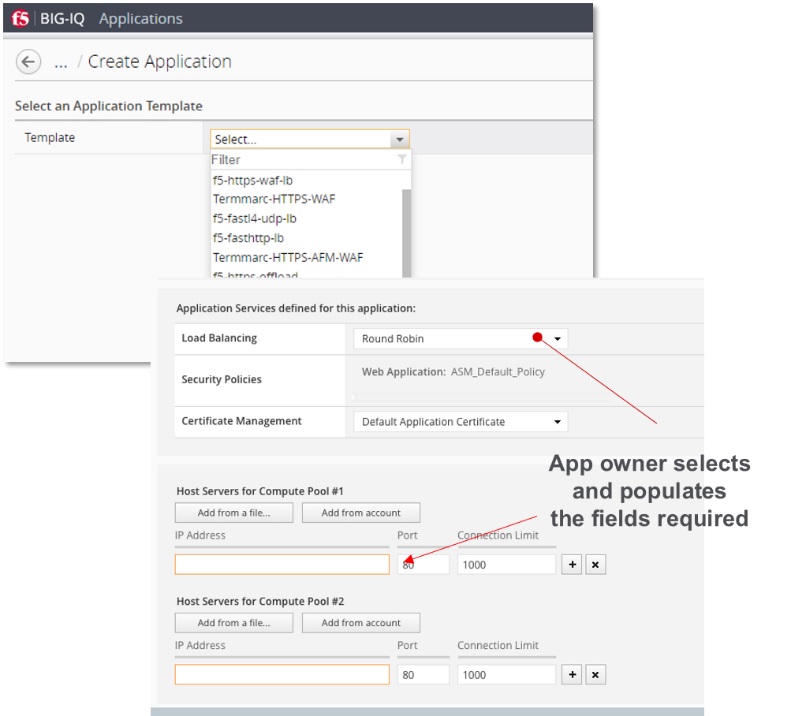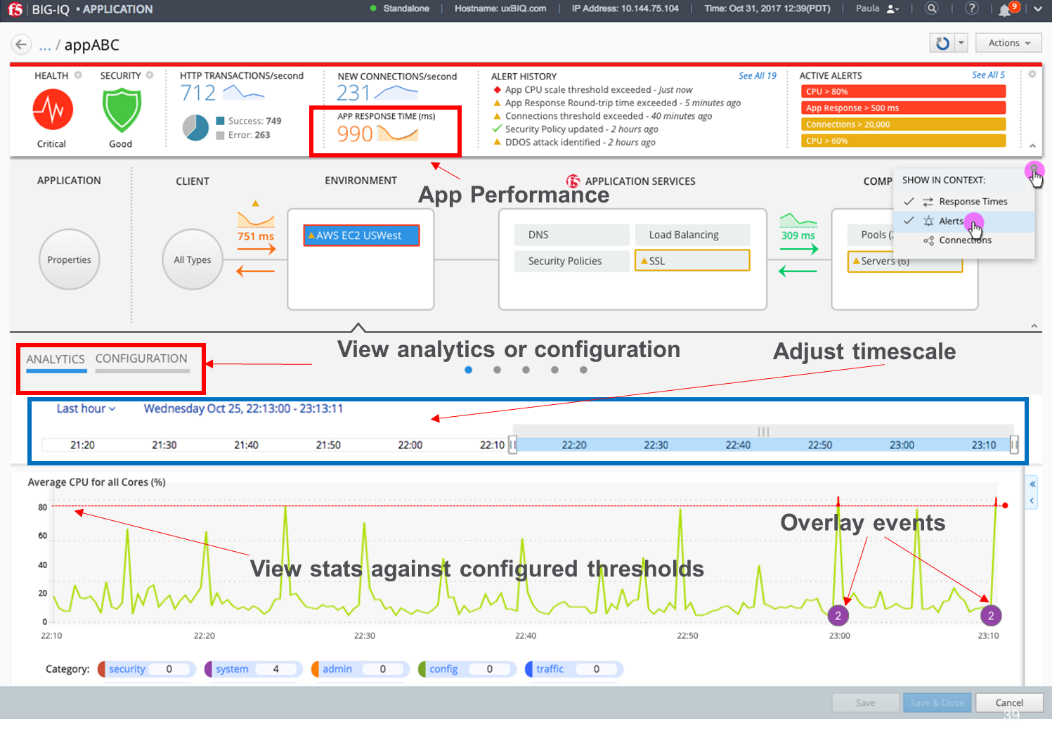Gerenciamento centrado em aplicativos com BIG-IP Cloud Edition
Na F5, os ADCs sempre se preocuparam com aplicações. Afinal, é disso que se trata o A em ADC. A F5 fez um bom trabalho ao focar na entrega de aplicativos – nossa comunidade de clientes, DevCentral , está repleta de guias de implantação específicos para aplicativos, iApps específicos para aplicativos, código de integração de aplicativos e dicas e truques sobre como melhorar o desempenho e a segurança dos aplicativos.
No entanto, os ADCs há muito tempo são domínio do profissional de rede, cuja função era fornecer serviços de rede, como balanceamento de carga e gerenciamento de tráfego, em suporte aos desenvolvedores de aplicativos. Bem, essa distinção rígida entre a rede e a aplicação é notícia de ontem. As organizações, motivadas pela necessidade de serem mais ágeis, estão migrando de um modelo organizacional hierárquico para algo mais parecido com uma abordagem de “rede de equipes”. Essa abordagem é caracterizada por um alto grau de capacitação para desenvolvedores, comunicações fortes, acesso baseado em funções à tecnologia e acesso rápido a análises.
Mas o que acontece quando a descentralização do DevOps encontra o movimento de desenvolvimento Agile? O que acontece é a necessidade de capacitar as equipes de aplicativos para definir e gerenciar seus próprios requisitos de rede. Para a F5, isso significa repensar como nossa tecnologia é gerenciada – repensar o papel dos administradores de rede.
Embora o BIG-IQ 5.4 tenha iniciado o caminho do Gerenciamento Centrado em Aplicativos, é com o BIG-IP Cloud Edition, suportado pelo BIG-IQ 6.0, que esse conceito realmente é abordado. Fazemos isso com quatro funções importantes, cada uma delas nova ou aprimorada. São essas quatro funções, juntamente com as implantações de ADC por aplicativo , que o Gerenciamento Centrado em Aplicativos se torna real. Vamos dar uma olhada:

1. Modelos de aplicativos – Na última versão do BIG-IQ (5.4), adicionamos a capacidade de criar modelos de aplicativos, bem como um catálogo desses modelos. Os modelos de aplicativos do BIG-IQ são uma maneira de padronizar as políticas de aplicativos necessárias para implantar um aplicativo em um catálogo de serviços. Na versão 5.4, esses modelos cobriam apenas políticas de LTM . O BIG-IQ 6.0 é capaz de criar modelos para a maioria dos módulos BIG-IP. O BIG-IQ também será fornecido com modelos para meia dúzia de aplicativos comuns.
O modelo de aplicativo é definido pelo especialista do domínio (normalmente o administrador de rede) e inclui os serviços de rede e segurança apropriados. O especialista em domínio cria o modelo e o adiciona a um catálogo de modelos de aplicativos. Ao fazer isso, ele ou ela pode copiar um aplicativo existente ou criar algo novo. O especialista em domínio configurará as configurações e exporá um conjunto limitado de opções de configuração ao proprietário do aplicativo. Dessa forma, a equipe do aplicativo poderá gerenciar os serviços de aplicativos da F5 sem precisar ser especialista em segurança ou configuração de ADC. Isso resulta em tempos de implantação de aplicativos mais rápidos, pois o proprietário do aplicativo tem uma interface de usuário simples de usar ou uma única chamada de API para implantar um aplicativo. O proprietário do aplicativo selecionará um modelo que corresponda à implantação desejada, preencherá os campos obrigatórios e clicará em “implantar” ou agendará para implantação posterior. O BIG-IQ também oferece suporte à criação de fluxos de trabalho para que as alterações e implantações sejam revisadas e até testadas antes de passarem para a produção. É tão simples quanto uma única chamada de API ou alguns cliques na interface do usuário para implantar um aplicativo do catálogo de serviços.
2. RBAC – Tudo começa com um controle de acesso baseado em função (RBAC) detalhado. O BIG-IQ sempre teve uma noção aproximada do RBAC com funções para gerenciar módulos-chave como Access, LTM, AFM... e funções abaixo disso para fluxos de trabalho como visualização, edição, preparação e implantação de políticas. Com a versão 5.4, melhoramos nosso jogo adicionando muito mais flexibilidade com controle baseado em funções. Com esta versão, agora você pode personalizar o acesso do usuário aos dispositivos gerenciados com base nas responsabilidades do trabalho. Isso permite que você conceda permissões específicas para visualizar ou modificar apenas os objetos BIG-IP que você atribui explicitamente a um usuário.
3. Dimensionamento automático – Desde o início da computação, as organizações de TI gastaram fortunas com provisionamento excessivo “para garantir”. Aplicativos em nuvens públicas também são, pelo menos teoricamente, capazes de adicionar ou remover capacidade conforme as necessidades do negócio mudam. Na realidade, isso não é tão simples. O BIG-IP Cloud Edition transforma essa teoria em realidade com suporte para dimensionamento automático. O BIG-IQ coleta análises avançadas sobre a integridade e o desempenho dos seus aplicativos. Quando métricas como tempos de resposta, latência, rendimento, etc. indicam a necessidade, o BIG-IQ pode criar dispositivos BIG-IP adicionais com base em modelos de dispositivos predefinidos. O BIG-IQ pode até aplicar licenças automaticamente conforme necessário. Quando o tráfego diminui, o BIG-IQ exclui automaticamente os dispositivos desnecessários e devolve a licença ao pool de licenças, economizando seu dinheiro e dando a você melhor controle sobre seus recursos.
Um grupo de dispositivos BIG-IP que trabalham juntos para fornecer serviços ADC escaláveis para um ou mais aplicativos é chamado de Grupo de Escala de Serviço (SSG). O BIG-IQ usará modelos de dispositivos para provisionar dispositivos BIG-IP recém-dimensionados e modelos de aplicativos para configurações específicas de aplicativos. Atualmente, o dimensionamento automático oferece suporte a ambientes VMware ESX e Amazon AWS.
4. Painéis específicos de função – Digamos que você seja um desenvolvedor de aplicativos responsável por um aplicativo de marketing. Você vai querer e precisar de uma maneira de rastrear o desempenho, a saúde e a configuração dos servidores que dão suporte a esse aplicativo, bem como os serviços F5 associados ao aplicativo. Ótimo, o BIG-IQ pode fazer isso. Mas digamos também que você não deve ter acesso às políticas de rede e segurança de outros aplicativos. O BIG-IQ 6.0 pode fornecer painéis específicos para sua função e para os aplicativos aos quais você está atribuído.

Esses painéis são mais do que apenas um colírio para os olhos. Eles não apenas fornecem informações rápidas sobre a integridade e o desempenho do seu aplicativo, como também permitem que você solucione problemas de desempenho rapidamente. Além disso, essas análises podem disparar automaticamente a ativação ou desativação de BIG-IPs virtuais adicionais conforme as condições de tráfego e desempenho mudam.
